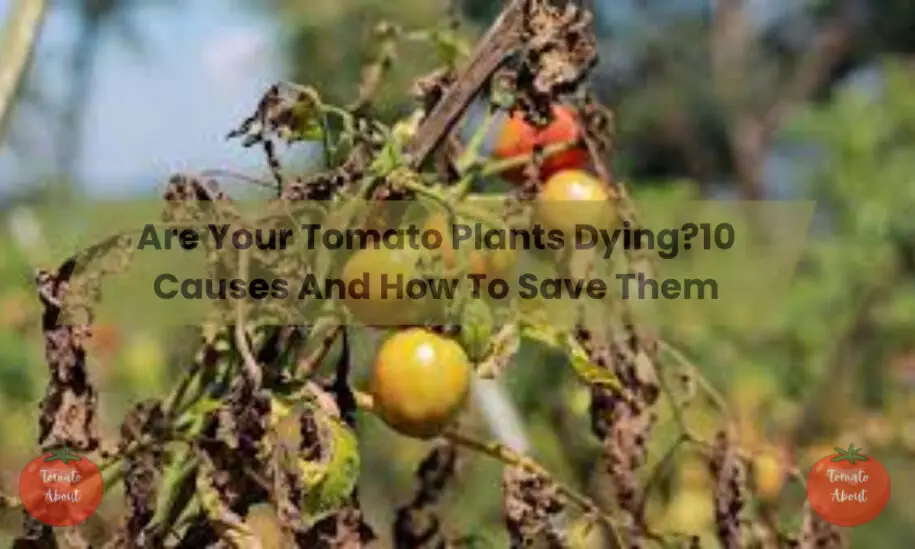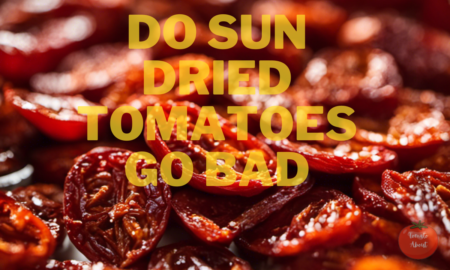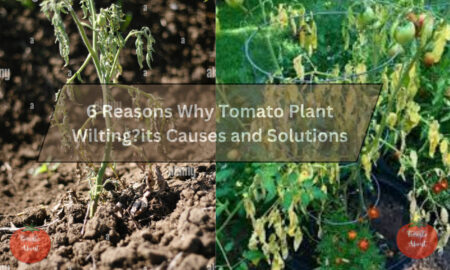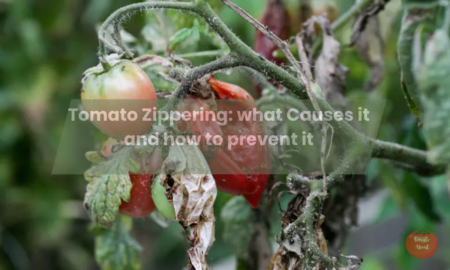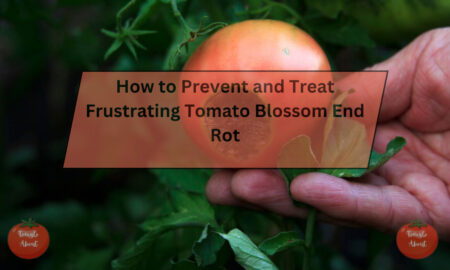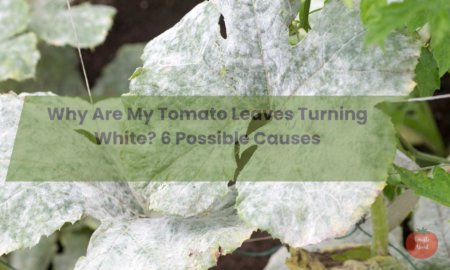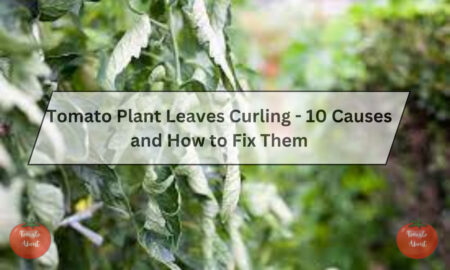Growing tomatoes is a rewarding but challenging endeavor. Between pests, disease, and environmental factors, so many things can go wrong with tomato plants. But when you provide the right care, these tasty summer treats will reward you with armloads of juicy red fruits.
If your tomatoes suddenly take a turn for the worse, resist the urge to immediately rip them out in frustration. Oftentimes, tomatoes can bounce back surprisingly well when you diagnose the underlying problem and take corrective action.
This guide will walk you through the 10 most common reasons tomato plants wilt, dry up, and potentially die. I’ll also provide actionable tips to fix these issues and nurse your plants back to full health and productivity. Let’s dig in!
10 Common Reasons Tomato Plants Die
1. Improper Watering
Inconsistent watering is one of the easiest ways to kill tomato plants. Tomatoes need a steady supply of moisture in the soil to thrive. Too much or too little water will cause significant problems.
Underwatering – Tomatoes are very susceptible to drought and need consistent moisture. If the soil dries out completely, the plants will show severe wilting within just a day or two. Leaves turn pale yellow and become very limp. Growth stalls as the plant struggles to survive.
If dry conditions persist, lower leaves start dropping off. Blossom end rot appears on fruits as uneven brown sunken areas on the bottom. Eventually, the plant will collapse and die if water is not restored.
To avoid underwatering, always water tomatoes at the soil level rather than overhead. For consistent results, use drip irrigation or self-watering containers to maintain optimal moisture.
Overwatering – While tomatoes need plenty of water, too much moisture can be just as damaging. Excess water limits the flow of oxygen to the roots, suffocating the plants. It also promotes fungal and bacterial disease.
Overwatered plants often show yellowing, drooping lower leaves. Leaves and flowers drop prematurely. Fruits split open. Growth is limited and what fruits do form are low quality. The saturated soil prevents roots from functioning properly.
To avoid overwatering, ensure the soil drains well. Add organic matter like compost to improve drainage in dense soils. Avoid waterlogged conditions and don’t rely on a strict watering schedule. Check the soil before watering.
Tip: Tomato plants need around 1-2 inches of water per week from either rainfall or irrigation. Water thoroughly at soil level about 2-3 times per week to maintain consistent moisture conditions.
2. Improper Lighting
As full-sun plants, tomato plants need at least 6-8 hours of direct sunlight daily to reach their full potential. But too little sunlight limits growth while too much sun can also stress plants.
Insufficient Sunlight – Tomatoes grow poorly without adequate sunlight. Low light causes weak, spindly growth as the plant reaches for sunlight. Canopies lack fullness and appear leggy.
Leaves on the upper portion of the plant turn pale yellow from an inability to photosynthesize sufficiently. Flowers and fruit will be very sparse, delaying harvest. Shaded plants also become more prone to disease.
If possible, move tomato plants into a sunnier location. For container plants, rotating the pots can help distribute light exposure. Reflective mulches increase ambient light. But significant shade usually requires supplementing with grow lights.
Excess Sunlight – While tomato plants love the sun, too much direct sun during hot summer weather can take its toll. Leaves appear yellow or burnt around the edges or develop brown spotting from sunscald.
Fruits also develop discolored patches and uneven ripening patterns from excess heat and sunlight exposure. To prevent stress, provide temporary shade structures or shade cloth when temperatures exceed 85°F and sunlight is most intense.
Tip: For optimal tomato health and productivity, site plants where they will receive full morning sun but partial shade in the hottest afternoon hours.
3. Extreme Temperatures
Tomatoes thrive in warm weather but will suffer once temperatures rise or dip too far in either direction. Watch for these common signs of temperature stress:
Heat Stress – Once temperatures exceed 90°F, tomato plants quickly begin to show signs of stress. Leaves droop and curl in response to intense heat and sunlight. Prolonged heat waves also cause blossom drop and aborted fruit set.
If high heat hits once fruits are developing, you may see yellow patches and uneven ripening due to sunscald. Leaf edges turn brown and crispy. Plants stop flowering and fruiting when excessively stressed.
To help tomatoes cope with heat waves, provide temporary shade over plants. Move container plants to cooler spots. Maintain ample soil moisture. Consider using a mist system to lower temperatures around plants.
Cold Stress – While not outright killed by frost like some plants, cold snaps and chilly nights significantly impact tomato growth and health. Exposure to temps below 50°F halts all growth and turns leaves purplish-black.
If frost threatens, protect plants by covering them with frost cloth overnight. Prolonged cold prevents pollination and fruit set due to lack of bee activity. Avoid planting tomatoes too early in spring before soils have warmed.
Tip: Wait to transplant tomatoes outdoors until nighttime temperatures are reliably above 55°F. Optimal daytime growing temperatures are 70-85°F.
4. Nutrient Deficiencies
Tomatoes are heavy feeders and require consistent nutrient levels over their lengthy growing season. Insufficient fertilization leads to reduced growth and common deficiencies include:
- Stunted plants with pale yellow upper leaves (nitrogen deficiency)
- Purplish leaves, stems, and undersides of leaves (phosphorus deficiency)
- Blotchy brown dead spots on leaf margins (potassium deficiency)
- Blossom end rot on fruits (calcium deficiency)
- Overall chlorotic, sickly plants (general starvation)
Before planting tomatoes, mix in several inches of compost and a balanced organic fertilizer to enrich the soil. Once planted, side-dress plants monthly with a nitrogen-rich fertilizer formulated specifically for tomatoes.
For container plants, apply a water-soluble tomato fertilizer every 2-3 weeks according to label directions. Adequate nutrition is critical for lush vegetation and loads of fruit.
Tip: Conduct a soil test to determine any nutrient shortages. Adjust soil pH to 6.0-6.5 range for optimal nutrient availability.
5. Diseases and Pests
Tomato plants are prone to several potentially devastating diseases and pests that can quickly kill them off if left uncontrolled. Common troublemakers to watch for include:
- Early and late blight – Caused by fungal infections, both show spreading leaf spots with light and dark areas. Entire plants can blight within a week.
- Fusarium and Verticillium wilt – These soil-borne fungal diseases clog water-conducting vessels, causing wilting. Plants often die.
- Hornworms – Large green caterpillars blend in well but eat foliage and fruits rapidly, causing severe damage.
- Aphids – Minute-sucking insects that transmit diseases. They cluster on stems and undersides of leaves.
- Tomato russet mites – Tiny mites cause yellow stippling on leaves. Can kill plants rapidly.

Promptly remove and destroy any infected plants or those heavily infested with pests. Treat outbreaks quickly using organic/chemical pesticides suited for tomatoes to maximize the chances of saving remaining plants.
6. Excessive Pruning
While pruning tomato plants is important for growth and yields, overzealous pruning can unduly stress plants. Avoid:
- Removing too many leaves reduces photosynthesis and plant vigor.
- Pruning off more than 2/3 of the plant’s height at once can shock plants into stunned growth.
- Pruning during periods of peak heat, drought stress, or fruiting, amplifies stress effects.
Instead, prune plants gradually over time. Remove lower leaves first while maintaining adequate foliage up top for growth and fruit development. Avoid heavy pruning during times of stress.
Tip: For indeterminate varieties that grow tall, prune plants to 1-2 main stems and remove suckers for best results. Determinants need less pruning.
7. Root Damage
Tomato roots are sensitive, and any harm to the roots can impact the entire plant. Potential sources of root damage:
- Compacted, dense soil that prevents roots from expanding and limits oxygen flow.
- Transplanting seedlings too early before they develop a robust root system.
- Allowing roots to completely dry out from drought, which desiccates fine root hairs.
- Excessive cultivation around plants that cuts and disturbs shallow roots.
- Diseases like root rot that kill off roots. Dead roots cannot take up water and nutrients.
To avoid root damage, prepare soil well with compost before planting. Transplant larger starter plants versus tiny seedlings. Apply organic mulch to conserve moisture and reduce compaction. Avoid over-tilling around plants.
8. Poor Soil Conditions
Tomatoes thrive in loamy, fertile soil with a pH between 6.0-6.5. Problems arise when soil is:
- Too dense, limiting drainage and oxygen flow to roots, causing suffocation.
- Too sandy, failing to retain moisture and nutrients needed by plants.
- Nutrient deficient, lacking nitrogen, phosphorus, calcium, and other essentials.
- Too acidic or alkaline. Tomato roots cannot access nutrients outside the optimal pH range.
Before planting tomatoes, test the soil and amend accordingly. To lighten heavy soils, mix in several inches of compost. Peat moss increases water holding in sandy soils. Use lime to raise the pH of acidic soils. Lower pH with sulfur if too alkaline.
For easier management, grow tomatoes in containers with commercial potting soil mixes amended per label directions.
9. Excessive Rainfall
Wet weather promotes fungal and bacterial diseases like early blight, late blight, and bacterial speck that can quickly defoliate and kill tomato plants. Prevent problems with these tips:
- Stake or trellis plants to lift foliage and prevent contact between leaves/fruits and disease organisms in the soil.
- Prune off lower leaves and branches to increase airflow through the canopy.
- Apply several inches of mulch to suppress soil splashing onto lower leaves during rains.
- Use drip irrigation to provide water at the soil level rather than wetting foliage.
- Spray plants preventatively with a copper fungicide labeled for tomatoes. Repeat after heavy rains.
Tip: Select disease-resistant tomato varieties optimized for your climate if excessive rain typically falls during summer months.
10. Setting Fruits in Cool Weather
Allowing tomato blooms to be successfully pollinated and set fruit when overnight temperatures are still cool (below 55°F) often leads to catfacing deformities as well as poor quality fruit later on. Issues include:
- Failed fruit set due to cold damage – Flowers drop off the vine when still in bud stage
- Rough, malformed fruit with raised scars, cracks, and holes (catfacing)
- Small, seedy fruits that fail to mature fully or ripen properly
- Higher risk of blossom end rot as plants struggle to take up calcium
When overnight lows dip below 55°F, cover plants to protect from frost damage. Remove any flowers or fruits until day and night temperatures warm. Delay planting tomatoes too early when cooler conditions prevail.
Conclusion
Growing robust tomato plants that remain healthy through harvest is an art honed through practice. Hopefully, this guide will equip you to quickly recognize and remedy the most common tomato ailments using both preventative measures and prompt treatment.
While finicky, don’t be intimidated by tomatoes! Start with disease-resistant varieties adapted to your climate, provide attentive care, and deal with issues swiftly. With close observation and quick response, your dying tomatoes can make a full recovery.
Here’s to many successful tomato gardening seasons ahead and baskets overflowing with juicy, vibrant tomatoes! Enjoy this rewarding summer harvest staple.

